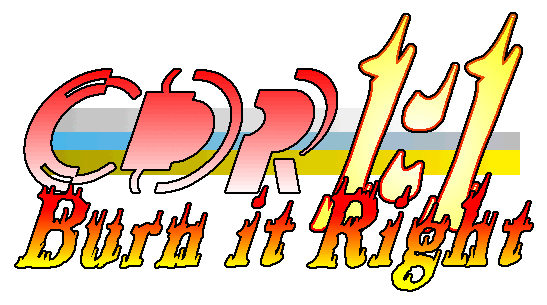

Before I bought my first CDRom burner I thought that duplicating disks would be as easy as just putting in the original, copying the files and directory structure to the hard drive, then copying it all back out to a blank CD. I'm sure that you know as well as I do now what folly this is. Making 1:1 (exact, bit for bit) copies of CDRoms is almost an art form. Thanks to software companies and commercial duplication systems for CDRoms we now have to deal with a wide ranging assortment of copy protection schemes that keep you from making a legal backup copy of the software you purchased. CDRom's are NOT indestructible! They're quite easily scratched and even broken (as a good friend of mine found out when he stepped on his SimCity 3000 CDRom disk) and of course as soon as such a tragedy happens you're out the $30-$50 you put out for the software because you can no longer use it! But see, when you purchase software, you're purchasing the rights to using the product and you have a right to protect your ability to use that product. Here I will show you how to protect your rights and make a backup copy of any software that you've purchased and own. These instructions are NOT here to help or encourage you to make illegal, pirated copies. With that all being said, let's move on to a run down of what we're dealing with so that you can the most out of your CDRom burner. Q: What kind of CDRom burner do you have, Loafy23? A: I have a Mitsumi CR4804TE 4x4x24 CDRom Burner. I've been told that this particular burner is actually made by Ricoh and just has a Mitsumi sticker put on it. This drive is an EIDE device that runs at UDMA2 speed on the EIDE bus. The drive has a 2 megabyte buffer to reduce and pretty much eliminate 'Buffer Under-Run' errors. This is NOT one of the most popular drives for making CDR's but I believe that that is due to the fact that a lot of people don't consider Mitsumi to be a real contender in the CDR market. I however absolutely LOVE this drive. It is a rock solid performer and the ONLY buffer under-run I've had was caused by a defective 80 minute CDR. Q: What kind/brand of media do you use? A: I use whatever I can find at a reasonable price. Currently I'm using Imation 74m media. It comes in a 100 pack spindle 'cake box' of 8X certified for about $74 with tax. For 80m media a friend and I split a 50 pack spindle of Smart and Friendly 8X certified disks which I believe were about $45 for 50. The CDRW's that I have are Smart and Friendly brand also. Luckily I was able to get a 5 pack of those for just under $10. Asking what's the best media and you'll get hundreds of conflicting answers. It seems that the answers are about on par with religious preferences. You'll get one person that tells you brand X is the greatest ever and that brand Z is total crap. The next person will tell you that brand Z is the only way to go and that you should avoid brand X like the plague. My advice??? Use what works for you. It seems that some burners just don't like certain brands of CDR although my Mitsumi hasn't had a problem with several different brands that I've burnt for friends. Q: Is SCSI better than IDE or Should I buy a SCSI burner? A: Sure SCSI is better than IDE. SCSI has a lot less CPU need than IDE. So you can get away with doing more while burning without any real fear of making a coaster. SCSI is also a lot more expensive than IDE. You can expect to pay about $40 at least for a good SCSI interface card plus about 10-20% more for a burner of equal stats to it's IDE counter part. Q: What's a buffer under-run error and what causes them? A: The buffer under- run error occurs when the CDR drive runs out of data while burning a disk. In other words some application or hardware bottle neck caused the data flowing to the CDR burner during the write process to slow down to the point that the drive was writing data faster than it was receiving data. Q: What can I do to minimize my risk of making coasters due to buffer under-runs? A: Turn off all hardware power saving features of your system. Disable screen savers. Run as few programs as possible. Don't do anything that will cause large amounts of disk activity. Be sure that your drives are healthy by running Scandisk and keeping the drives defragmented. You can also for go speed for reliability. By dropping back on the speed that you are burning at you increase the likelihood of making a good disk. But probably the MOST important thing to do is this: Never do on-the-fly disk duplication. By not making an image and burning from that image you're putting yourself at a high risk for buffer under-runs due to failed reads and limited bandwidth of other CDRom drives. Q: What's an image file? A: An image file is essentially the whole CD that you're
duplicating put into one massive file that will reside on a hard drive which has much
higher data through put than a CDRom drive. Here's the list of titles and the process used to make a 1:1 duplication of the disk(s) CDC = Easy CD Creator's CD Copier was used to read AND write this disk. MORE TO COME |
![]()
Hell yes! I support free speech on the 'net! Maybe you should too.
![]()